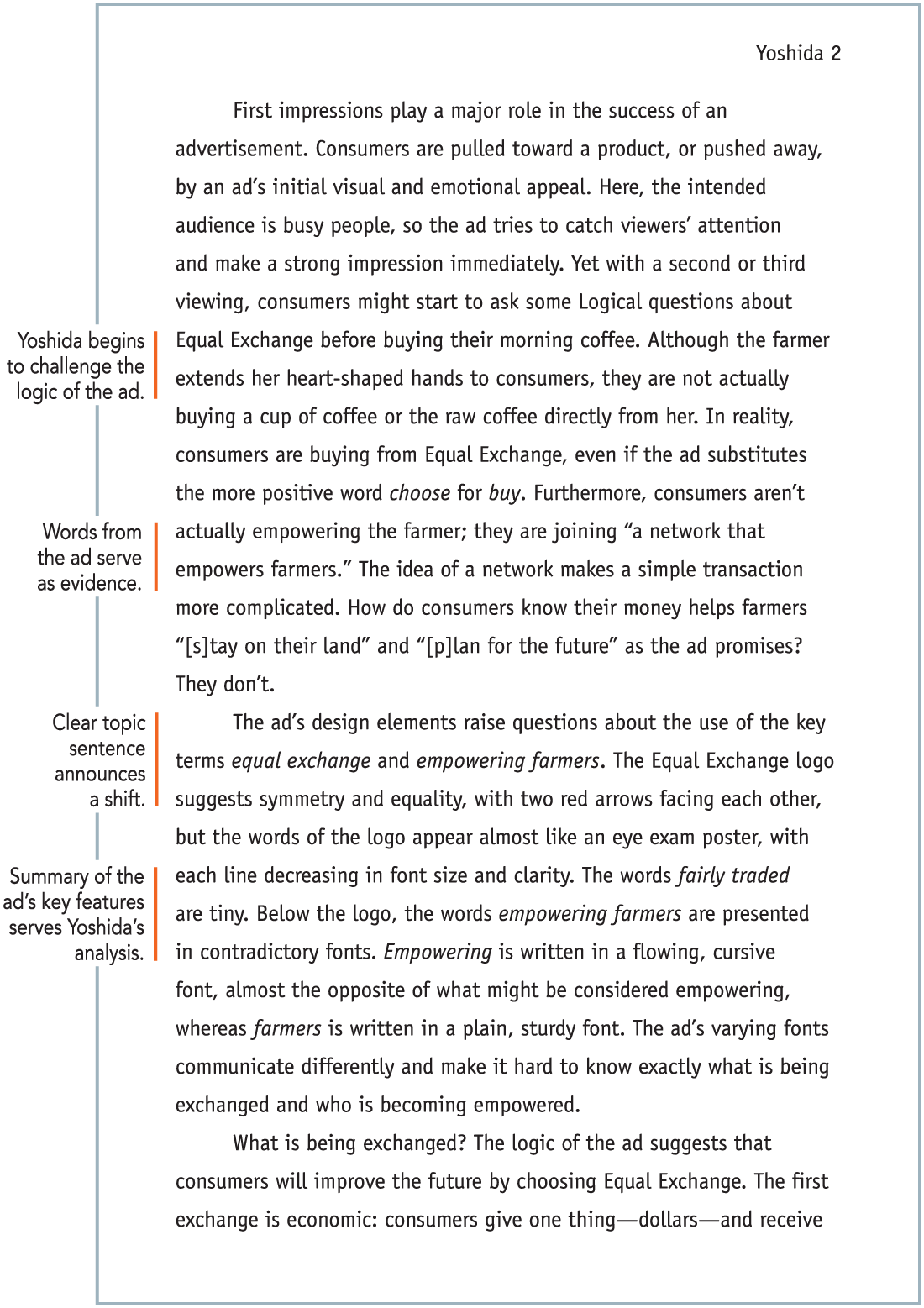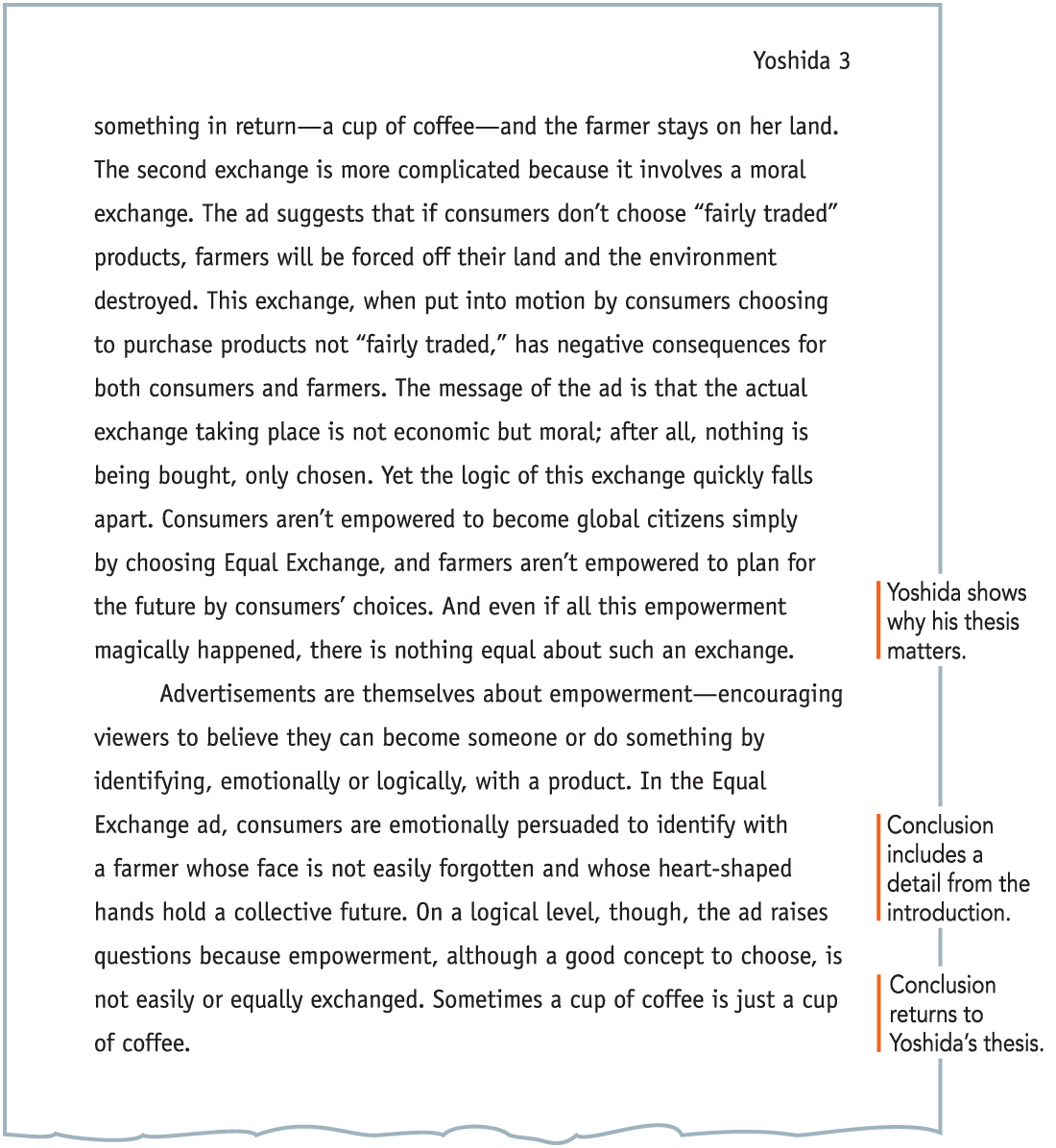In many of your college classes, you’ll have the opportunity to read and write about multimodal texts, such as advertisements, videos, or websites. Multimodal texts combine two or more of the following modes: words, static images, moving images, and sound. Like a print text, a multimodal text can be read carefully to understand what it says and how it communicates its purpose and reaches its audience.
Annotate a multimodal text to understand the message and ask questions The first step is to become familiar enough with the text that you can state its central idea and key points simply and objectively. Taking notes on the text will help you do that. One student, Ren Yoshida, annotated an advertisement for fairly traded coffee. He made an effort to understand the message of the ad and questioned some of the language used by the composer. You can see the ad below.
A text on the accompanying photo on the left reads, Equal Exchange Fairly Traded. [Margin notes read, What is being exchanged? Why is open quotes fairly traded close quotes so hard to read? End margin notes.] The text below reads, empowering farmers. [Margin notes read, open quotes Empowering close quotes m dash why in an elegant font? Who is empowering farmers? open quotes Farmers close quotes in all capital letters m dash shows strength? End margin notes.] A photo below shows a woman extending a handful of coffee beans. [Margin notes read, Straightforward design and not much text. Outstretched hands. Is she giving a gift? Inviting partnership? Hands: heart-shaped, foregrounded. Raw coffee beans are red: earthy, natural, warm. End margin notes.] A text below the photo reads, When you choose Equal Exchange fairly traded coffee, tea, or chocolate, you join in a network that empowers farmers in Latin America, Africa, and Asia to: Stay on their land, Care for the environment, Farm organically, Support their family, Plan for their future. www.equalexchange.coop. [Margin notes read, Positive verbs: consumers choose, join, empower; farmers stay, care, farm, support, plan. How do consumers know their money helps farmers stay on their land?]
Analyze a multimodal text to demonstrate your critical reading When you analyze a multimodal text, you say to readers “Here’s my reading of this text. This is what the text means and why it matters.” Analysis begins with asking why and how questions about a multimodal text to help you form a judgment about it. When Ren Yoshida analyzed the Equal Exchange advertisement, he asked questions about the ad’s design details and its emotional and logical appeals, and he focused his thesis by questioning a single detail in the ad. On the following pages is Yoshida’s analysis of the ad.
A text on the top right corner of the page reads, Yoshida 1. A text on the top left corner of the page reads, Ren Yoshida, Professor Marcotte, English 101, 4 November 2015. The title of the text reads, Sometimes a Cup of Coffee Is Just a Cup of Coffee.
New paragraph. A farmer, her hardworking hands full of coffee beans, reaches out from an Equal Exchange advertisement (open quotes Empowering close quotes). [A margin note reads, The source is cited in the text. No page number is available for the online source. End margin note.] The hands, in the shape of a heart, offer to consumers the fruit of the farmer’s labor. The ad’s message is straightforward: in choosing Equal Exchange, consumers become global citizens, partnering with farmers to help save the planet. Suddenly, a cup of coffee is more than just a morning ritual; a cup of coffee is a moral choice that empowers both consumers and farmers. [A margin note reads, Yoshida summarizes the content of the ad. End margin note.] This simple exchange appeals to a consumer’s desire to be a good person—to protect the environment and do the right thing. Yet the ad is more complicated than it first seems, and its design raises some logical questions about such an exchange. Although the ad works successfully on an emotional level, it is less successful on a logical level because of its promise for an equal exchange between consumers and farmers. [A margin note reads, Thesis expresses Yoshida’s analysis of the ad. End margin note.]
New paragraph. The focus of the ad is a farmer, Jesus Choqueheranca de Quevero, and, more specifically, her outstretched, cupped hands. Her hands are full of red, raw coffee, her life’s work. The ad successfully appeals to consumers’ emotions, assuming they will find the farmer’s welcoming face and hands, caked with dirt, more appealing than startling statistics about the state of the environment or the number of farmers who lose their land each year. [A margin note reads, Details show how the ad appeals to consumers’ emotions. End margin note.] It seems almost rude not to accept the farmer’s generous offering since we know her name and, as the ad implies, have the choice to open quotes empower close quotes her. [A margin note reads, Yoshida interprets details such as the farmer’s hands. End margin note.] In fact, how can a consumer resist helping the farmer open quotes [c]are for the environment close quotes and open quotes [p]lan for the future, close quotes when it is a simple matter of choosing the right coffee? The ad sends the message that our future is a global future in which producers and consumers are bound together.
A text on the top right corner of the page reads, Yoshida 2.
New paragraph. First impressions play a major role in the success of an advertisement. Consumers are pulled toward a product, or pushed away, by an ad’s initial visual and emotional appeal. Here, the intended audience is busy people, so the ad tries to catch viewers’ attention and make a strong impression immediately. Yet with a second or third viewing, consumers might start to ask some Logical questions about Equal Exchange before buying their morning coffee. Although the farmer extends her heart-shaped hands to consumers, they are not actually buying a cup of coffee or the raw coffee directly from her. [A margin note reads, Yoshida begins to challenge the logic of the ad. End margin note.] In reality, consumers are buying from Equal Exchange, even if the ad substitutes the more positive word choose for buy. Furthermore, consumers aren’t actually empowering the farmer; they are joining open quotes a network that empowers farmers. Close quotes [A margin note reads, Words from the ad serve as evidence. End margin note.] The idea of a network makes a simple transaction more complicated. How do consumers know their money helps farmers open quotes [s]tay on their land close quotes and open quotes [p]lan for the future close quotes as the ad promises? They don’t.
New paragraph. The ad’s design elements raise questions about the use of the key terms equal exchange and empowering farmers. [A margin note reads, Clear topic sentence announces a shift. End margin note.] The Equal Exchange logo suggests symmetry and equality, with two red arrows facing each other, but the words of the logo appear almost like an eye exam poster, with each line decreasing in font size and clarity. The words fairly traded are tiny. Below the logo, the words empowering farmers are presented in contradictory fonts. [A margin note reads, Summary of the ad’s key features serves Yoshida’s analysis. End margin note.] Empowering is written in a flowing, cursive font, almost the opposite of what might be considered empowering, whereas farmers is written in a plain, sturdy font. The ad’s varying fonts communicate differently and make it hard to know exactly what is being exchanged and who is becoming empowered.
New paragraph. What is being exchanged? The logic of the ad suggests that consumers will improve the future by choosing Equal Exchange. The first exchange is economic: consumers give one thing m dash dollars m dash and receive
A text on the top right corner of the page reads, Yoshida 3.
The text reads, something in return m dash a cup of coffee m dash and the farmer stays on her land. The second exchange is more complicated because it involves a moral exchange. The ad suggests that if consumers don’t choose open quotes fairly traded close quotes products, farmers will be forced off their land and the environment destroyed. This exchange, when put into motion by consumers choosing to purchase products not open quotes fairly traded, close quotes has negative consequences for both consumers and farmers. The message of the ad is that the actual exchange taking place is not economic but moral; after all, nothing is being bought, only chosen. Yet the logic of this exchange quickly falls apart. Consumers aren’t empowered to become global citizens simply by choosing Equal Exchange, and farmers aren’t empowered to plan for the future by consumers’ choices. And even if all this empowerment magically happened, there is nothing equal about such an exchange. [A margin note reads, Yoshida shows why his thesis matters. End margin note.]
New paragraph. Advertisements are themselves about empowerment m dash encouraging viewers to believe they can become someone or do something by identifying, emotionally or logically, with a product. In the Equal Exchange ad, consumers are emotionally persuaded to identify with a farmer whose face is not easily forgotten and whose heart-shaped hands hold a collective future. [A margin note reads, Conclusion includes a detail from the introduction. End margin note.] On a logical level, though, the ad raises questions because empowerment, although a good concept to choose, is not easily or equally exchanged. Sometimes a cup of coffee is just a cup of coffee. [A margin note reads, Conclusion returns to Yoshida’s thesis. End margin note.]
A text on the top right corner of the page reads, Yoshida 4.
New paragraph. Work Cited
New paragraph. Open quotes Empowering Farmers. Close quotes Equal Exchange, equalexchange.coop/. Advertisement. Accessed 14 October 2015. [A margin note reads, Yoshida gives date of access for an undated source. End margin note.]




